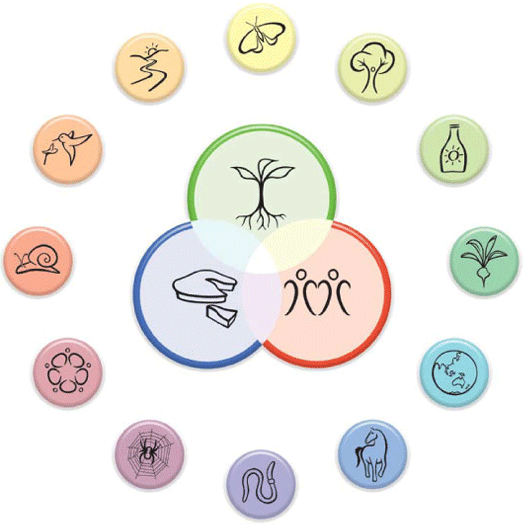Permaculture Principles
The principles are thinking tools, that when used together, allow us to creatively re-design our environment and our behavior in a world of less energy and resources – David Holmgren
Principle 1: OBSERVE AND INTERACT
Beauty is in the eye of the beholder
By careful observation and thoughtful interaction, we look at nature as an inspiration for our designs. We seek to gather as much first hand information and different perspectives as possible to help understand what is going on with the various elements in the system.
Principle 2: CATCH AND STORE ENERGY
Make hay while the sun shines
By developing systems that collect resources and store them long-term, we create resilience and true wealth. The best place to store this wealth is in the soil, water, trees, or seeds as all are self maintaining, easily used, and resistant to monopolization
Principle 3: OBTAIN A YIELD
You can’t work on an empty stomach
Ensure that you are getting truly useful rewards as part of the work that you are doing. Yield can be in the form of food, knowledge, experience, or a resource. If the system is not generating a yield it will struggle to be sustainable.
Principle 4: APPLY SELF-REGULATION AND ACCEPT FEEDBACK
The sins of the fathers are visited on the children unto the seventh generation
Continuously re-evaluate your systems and respond to feedback mechanisms just as natural ecosystems depend on feedback models to keep balanced.
Principle 5: USE AND VALUE RENEWABLE RESOURCES AND SERVICES
Let nature take its course
Make the best use of nature’s abundance to reduce our consumptive behavior and dependence on non-renewable resources. Ensure that use is within the renewable limits of the resource – a non consuming use is preferred over a consuming one.
Principle 6: PRODUCE NO WASTE
A stitch in time saves nine
Design your system with closed loops, value every resource, and nothing goes to waste. Remember, there is no such thing as waste in nature. The output of any element should match up as the input of another element. Maintanence is key as there is less embodied energy to maintain than to allow to crash and rebuild
REFUSE => REDUCE => REUSE => REPAIR => RECYCLE
Principle 7: DESIGN FROM PATTERNS TO DETAILS
Can’t see the wood for the trees
By zooming out, we observe patterns in nature and society. These patterns form the backbone of our design. Why try to reinvent the wheel, if nature has been fine-tuning her systems for billions of years.
Principle 8: INTEGRATE RATHER THAN SEGREGATE
Many hands make light work.
By studying relationship between elements, permaculture aims at designing integrated solutions to problems. Build in redundancy and multiple functions with every need being met by multiple elements, and every element having multiple functions.
Principle 9: USE SMALL AND SLOW SOLUTIONS
The bigger they are, the harder they fall
Small and slow as an alternative to big is better. By working locally and growing slowly, we are able to work more efficiently, naturally and sustainably. The best design solutions are; small scale, simple to maintain, are labor intensive rather than energy or capital intensive, use local resources or support local markets.
Principle 10: USE AND VALUE DIVERSITY
Don’t put all your eggs in one basket.
Diversity reduces vulnerability to a variety of threats and takes advantage of the unique nature of the environment in which it resides. Diversity in permaculture is not a random assembly of objects, but the number of functional connections between them that leads to a productive system. Diversity equals stability.
Principle 11: USE EDGES AND VALUE THE MARGINAL
Don’t think you are on the right track just because it is a well-beaten path
The interface between elements or systems is where the most interesting events take place. They are more biologically productive and hold more species as they have the stability and abundance of both systems combined.
Principle 12: CREATIVELY USE AND RESPOND TO CHANGE
Vision is not seeing things as they are but as they will be
We can have a positive impact on inevitable change by carefully observing, and then intervening at the right time. We must remember that change is much more than a linear projection.
 surpluspermaculturedesign
surpluspermaculturedesign